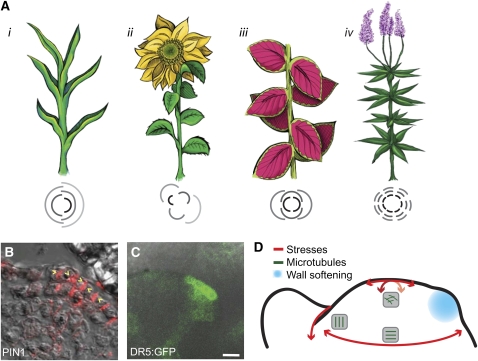Figure 2.
Phyllotaxis: the Relative Positioning of New Leaves.
(A) Four major phyllotactic patterns depicted as plants and as top view line diagrams showing relative leaf positions: (i) distichous with a divergence angle of 180° (maize), (ii) spiral with an angle of ∼137.5° (sunflower), (iii) decussate with pairs of leaves at 90° (Solenostemon sp), and (iv) whorled with three or more leaves originating from the same node (Veronicastrum virginicum). In line diagrams, lighter gray indicates older leaves.
(B) Immunolocalization of PIN1 protein in an Arabidopsis vegetative meristem. PIN1 exhibits polar localization within the L1 (direction indicated by yellow arrow heads). (Image provided by E.R. Pesce and C. Kuhlemeier.)
(C) Expression of the auxin responsive reporter DR5:GFP in an Arabidopsis inflorescence meristem. Bar = 10 μm. (Reproduced from Smith et al. [2006].)
(D) Tissue mechanics and components within the meristem as illustrated by major axis of stress (red arrows) and the coincident microtublue organization (green lines in gray boxes), as described by Hamant et al. (2008). Predicted wall softening (expansin activity and pectin modification) at the site of a new leaf in blue.

